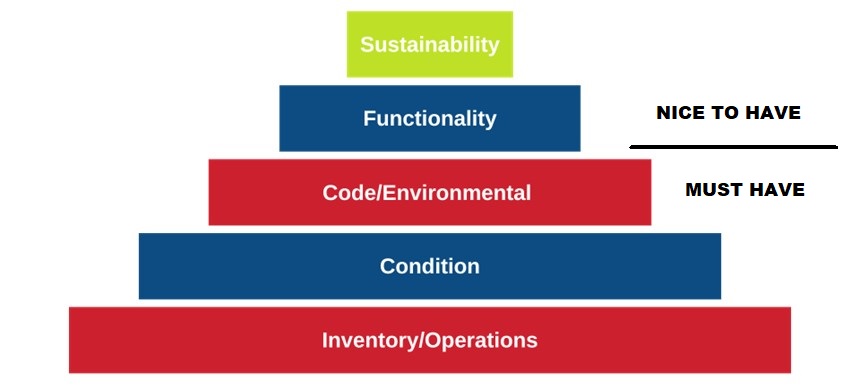We are going to take a break from our regularly scheduled trip through the layers of the Onion (Our Integrated Asset Management Framework) and instead look at climbing the “Pyramid” (see above) we use to demonstrate the Hierarchy of Existing Facility Data Needs. This post will focus on the first three tiers of the pyramid, what we call the “Must Haves”. Next week, I will finish off with the top two tiers or the “Nice to Haves”.
Before I dive into each data type or stream within the pyramid, I want to reiterate that the hierarchy has been built for existing buildings, If you were going to design a new building you would start at the top of the pyramid and work your way down. However, our focus is (almost) exclusively on existing buildings, and as such we recommend that you begin at the bottom of the pyramid and work your way up since you are dealing with real world, bricks and mortar assets.
Inventory/Operations
The base of the pyramid deals with the most granular level of data that you typically manage within a building, your equipment inventory, which generally drives your maintenance activities within your facility. To properly build a Preventative Maintenance Program or even to just track the costs associated with reactive maintenance, you need to have an understanding of what equipment is present within your facility. As part of the process, we highly recommend that you also tag the equipment with a barcode or QR code to make data management and retrieval easier. We call this process Equipment Inventory & Tagging (EI&T).
Condition
The next stage of the pyramid or data stream is your condition data, generally developed as part of a Facility Condition Assessment (FCA). FCA data is typically at the element level, which involves rolled up inventory data based on similar dates of construction, condition, material type, etc.
For example, in your inventory you may have three individual boilers. However, in your FCA if two boilers are older and one is newer you would likely have two elements, one for the two older boilers and one of the new boiler. If they were all the same age/condition, etc. you would likely only have one boiler element, with a quantity of 3.
In theory, if you collect your inventory data you can begin to roll it up into element level data that can form the basis of your condition dataset. However, most clients do not have a detailed enough inventory, or have gathered their FCA dataset prior to completing their EI&T process. Additionally, if you develop your FCA dataset properly, you can also extract EI data from the FCA dataset for certain types of equipment.
With a detailed understanding of your condition you are able to forecast your future renewal needs and gain an understanding of your Deferred Capital Renewal and Maintenance Backlog.
Code/Environmental
The third layer of the pyramid is Code and Environmental data. Although these items are generally legislated, in most cases issues that exist are grandfathered and generally only require addressing when completing capital renewal (often condition-based) projects. Most organizations have a fairly clear understanding of their environmental issues, particularly asbestos-containing materials (ACMs). However, often the data is not integrated into the capital planning process. The worst words that a Project Manager can hear during a renewal project is “what’s that” and it turns out to be unexpected ACMs.
With regards to regulatory information, most organizations only do deep dive code reviews as part of preconstruction activities/design, which makes perfect sense as the issues only need to be addressed when disturbing the element. Doing a detailed code assessment of an entire building is very expensive and if you are not doing specific construction, you risk a change in certain codes between the time when you do the assessment and the time of the actual construction activities.
However, for the purposes of preliminary capital planning, we often recommend that clients consider adding a contingency for addressing code issues when certain types of work are being done in older facilities.
The one specific regulatory issue that I do want to call out is Accessibility. Depending on the jurisdiction that you operate in, Accessibility can be very time sensitive with regards to mandated compliance. Generally, with the Americans with Disabilities Act (ADA), the requirements are fairly standard across the U.S. Within the Canadian market, each province has slightly different requirements and levels of regulation. It is important that you understand the applicable accessibility requirements and you have an understanding of the issues that exist within your facilities. Ideally, we recommend that you use the Uniformat II element structure for your accessibility data so that you can easily integrate it with your condition dataset when doing a capital plan.




